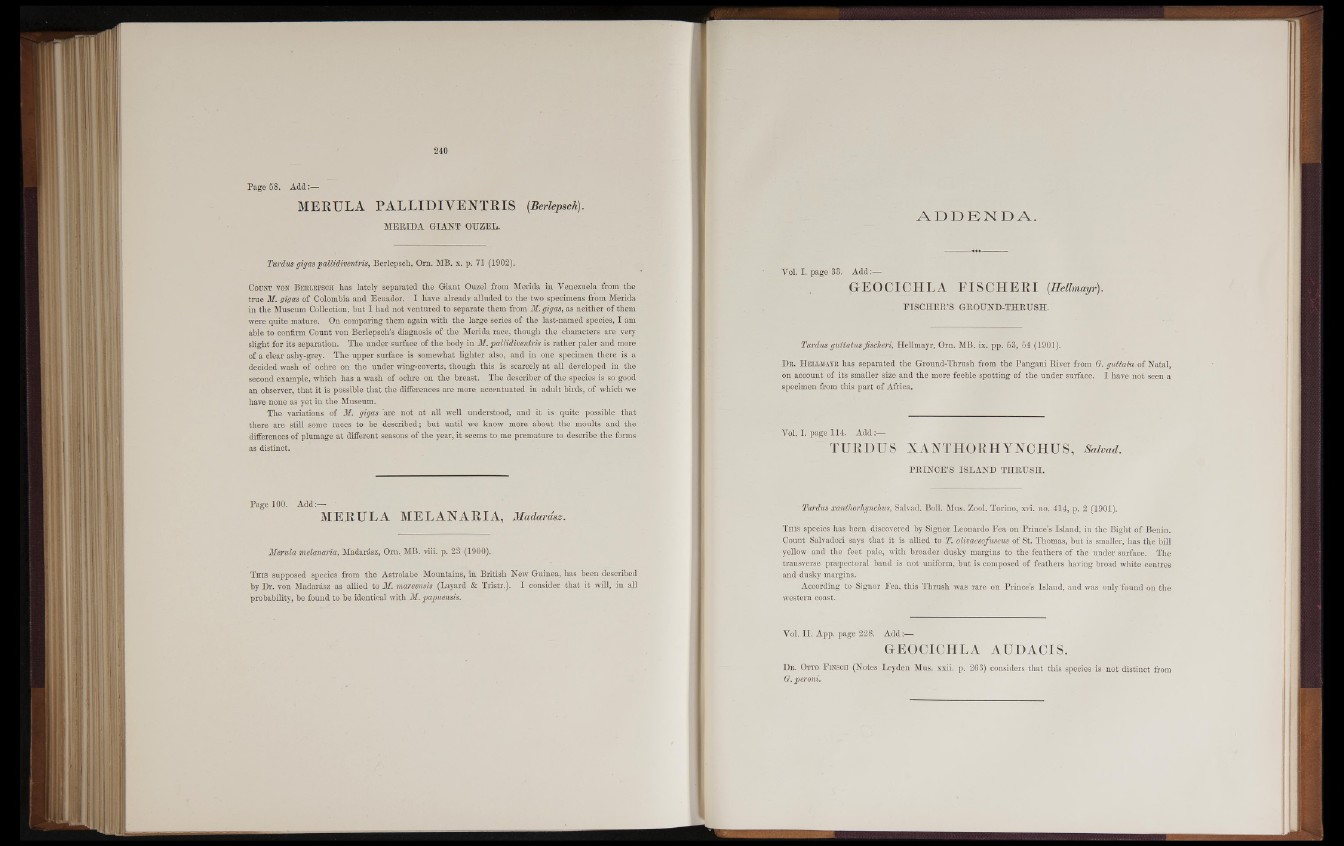
Page 58. Add:—
MEETJLA P A L L ID IV E N T E I S [Berlepsch).
MERIDA GIANT OUZEL.
Turdus gigaspallidiventris, Berlepsch, Om. MB. x. p. 71 (1902).
Count von Berlepsch has lately separated the Giant Ouzel from Merida in Venezuela from the
true M. gigas of Colombia and Ecuador. I Kave already alluded to the two specimens from Merida
in the Museum Collection, but I had not ventured to separate them from M. gigas, as neither of them
were quite mature. On comparing them again with the large series of the last-named species, I am
able to confirm Count von Berlepsch’s diagnosis of the Merida race, though the characters are very
slight for its separation. The under surface of the body in M. pallidiventris is rather paler and more
of a clear ashy-grey. The upper surface is somewhat lighter also, and in one specimen there is a
decided wash of ochre on the under wing-coverts, though this is scarcely at all developed in the
second example, which has a wash of ochre on the breast. The describer of the species is so good
an observer, that it is possible that the differences are more accentuated in adult birds, of which we
have none as yet in the Museum.
The variations of M. gigas "are not at all well understood, and it is quite possible that
there are still some races to be described; but until we know more about the moults and the
differences of plumage at different seasons of the year, it seems to me premature to describe the forms
as distinct.
Page 100. Add:—
M E R U L A M E L A N A R IA , Madarâsz.
Merula melanaria, Madarâsz, Ora. MB. viii. p. 28 (1900).
T his supposed species from the Astrolabe Mountains, in British New Guinea, has been described
by Dr. von Madarâsz as allied to i f mareensis (Layard & Tristr.). I consider that it will, in a l
probability, be found to be identical with M. papuensis.
A D D E N D A .
Vol. I. page 33. Add:—
GrEOCICHLA E I S C H E R I [Hellmayr).
FISCHER'S GROUND-THRUSH.
Turdus guttatus Jischeri, Hellmayr, Orn. MB. ix. pp. 53, 54 (1901).
D r. H ellmayr has separated the Ground-Thrush from the Pangani River from G. guttata of Natal,
on account of its smaller size and the more feeble spotting of the under surface. I have not seen a
specimen from this part of Africa.
Vol. I. page 114. Add :—
T U R D U S X A N T H O R H Y N C H U S , Salvad.
PRINCE’S ISLAND THRUSH.
Turdus xanthorhynchus, Salvad. Boll. Mus. Zool. Torino, xvi. no. 414, p. 2 (1901).
T his species has been discovered by Signor Leonardo Pea on Prince’s Island, in the Bight of Benin.
Count Salvadori says that it is allied to T. olivaceofuscus of St. Thomas, but is smaller, has the bill
yellow and the feet pale, with broader dusky margins to the feathers of the under surface. The
transverse prsepectoral band is hot uniform, but is composed of feathers having broad white centres
and dusky margins.
According to Signor Pea, this Thrush was rare on Prince’s Island, and was only‘found on the
western coast.
Vol. II. App. page 228. Add:—
G EOC ICHL A A U D A C I S .
D r . Otto F insch (Notes Leyden Mus. xxii. p. 263) considers that this species is not distinct from
G. peroni.